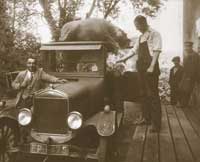Past &
Future
History
1929 |
Wool Co-operative Society formed with a depot at Stamford providing 'great value to all wool growers in the East Midlands'. Lord Exeter purchased freehold of the Wothorpe Malting on the Society's behalf at a cost of £1,500. Society repaid him at 5% interest. Fleeces washed then sold through auction at the London Wool Exchange through Jacomb, Hoare & Co. 75,020 fleeces handled from 11 counties and sold at prices ranging from 12d. to 13.5d. (per lb) for Lincolnshire ewes to 17.25d. for Hampshire ewes. |
1930 |
87,426 fleeces received. With the commencement of the worldwide slump, the price of wool falls sharply. Many wool merchants go out of business and it is decided to hold on to stock to see if prices improve. |
1949 |
60,572 fleeces received. Society takes on the lease of Newstead Mill, Stamford in order to store bales. |
1950 |
Producers vote in favour of proposed Wool Marketing Board. |
1952 |
Uffington Road, Stamford purchased from Lord Exeter. |
1955 |
First permanent grader – Ben Waterhouse employed; traditionally graders came from Bradford. |
1960 |
Aerodrome hanger purchased and re-erected as grading/bin centre. |
1964 |
Society purchases Scottish, English & Welsh Wool Growers’ business and premises at Towcester, thus acquiring a second wool grading centre dealing with 100,000 fleeces, bringing the total to nearly 350,000 fleeces. |
1967 |
Society takes over wool in Lincolnshire & Nottinghamshire, previously handled by private merchants to whom the Society pays goodwill. |
1970 |
Eastern Wool Growers suffers disastrous fire and are forced out of business. CWG takes over all wool produced in Suffolk. |
1973 |
New, purpose built, 24,000sq ft bale store at Stamford provides an additional wool shed. |
1978 to 2001 |
Society established retail stores in East of England, Lincolnshire and Midlands. Freehold of 6 retail stores purchased at Bury St Edmunds, Darley Dale, Dereham, Fauld, Market Rasen and Worksop, in addition to the flagship store at Stamford. |
2007 |
Wool Department takes on producers from Oxfordshire, Berkshire and Buckinghamshire and grades 1.76 million kilos of wool. |
2008 |
Wool from Warwickshire producers sent from Wool Board depot in Bromyard, when it changes to a collection centre, to be graded at Stamford. |
2009 |
Warwickshire producers are transferred from Bromyard and new Intermediate Collection Depot set up near Hunningham, Leamington Spa, which proves huge success. |
2010 |
Mole Valley purchase CWG retail operation and name reverts to Central Wool Growers Ltd. The residual co-operative retains freehold of 7 depots, which are initially leased to Mole Valley on 15 year arrangement, in addition to Wool department. Producer numbers and wool intake stay stable as Wool Prices increase, promising a more secure future. |
2011 |
Board took decision to relocate the wool grading operation, and the Society’s Head Office, to new location in Essendine, 4 miles from Stamford. New wool collection points set up. |
2016 |
Wool Operation and Head Office moved back to Uffington Road, Stamford, due to Mole Country Stores Transport Operation being relocated to Kettering. |
2019 |


Company celebrated 90th Anniversary at the November AGM. The first photograph shows Andrew Moore and Terry Baxter - front (previous Managing Directors), with Steve Fleming and Nick Kidd (present Board). Second photo includes employees and some shareholders. |
2021 |
With global impact from the pandemic, Wool Operation ceased and association with British Wool came to an end. Company continues to concentrate on the property rental for the benefit of shareholders and pensioners. |
2023 |
Darley Dale sold to the neighbouring company in November, as MVF wished to move to a larger site. See map below for properties leased by Mole Country Stores: |








